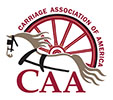
It is safe to say that most carriage collections do not include a bandwagon, however, many historical societies and museums have photographs of community bandwagons within their collections. Those vehicles can look very different from each other leading to the question, “Are there different types of bandwagons?”
Richard E. Conover, in his book, The Fielding Bandchariots, defined bandwagons where the musician’s feet were on the floor of the wagon bed as shell bandwagons or bandchariots. Bandwagons where the musicians rode on the roof were known as tableau baggage bandwagons. By contrast most carriage makers tend to simply defined bandwagons as either bandwagons or circus bandwagons. Matt Holdzkom, a circus history enthusiast shares on his website, “Tableaus were decorated with carvings, mirrors, and sometimes painted murals. Tableaus were also often used as bandwagons for secondary bands.” By contrast most carriage makers tend to simply defined bandwagons as either bandwagons or circus bandwagons.

Bandwagons

Villages, lodges, and even factories had bands during the mid-1800s, it was seen as a sign of culture and civilization. As a result the bandwagon or village bandwagon was often decorated in rich colors befitting the bands social status but without the ornateness seen in circus wagons. Front wheels were typically in the 40-43″ range with the rear wheels in the 50s – high enough that the musicians were above the crowd as they played their instruments.
If an organization did not own their own bandwagon it was possible to rent one. The Cincinnati Enquirer (Ohio) on August 20, 1882 makes mention of a 10-mile parade, “One of the biggest street parades the West has ever seen.” Pageant notes include an approval of $30.00 for Captain P. R. Way to procure a large Band-wagon to seat forty young ladies, to be drawn by six white horses.
 This bandwagon was made in Scranton, Pennsylvania about 1912 and was part of the John M. Seabrook Collection. In 1982 it was the carriage part was painted royal blue, the body was white and blue. We’re fortunate to have detailed information about this particular vehicle in the archives:
This bandwagon was made in Scranton, Pennsylvania about 1912 and was part of the John M. Seabrook Collection. In 1982 it was the carriage part was painted royal blue, the body was white and blue. We’re fortunate to have detailed information about this particular vehicle in the archives:
Length of body – 19 feet, 6 inches
Wheels – front 42 inches, rear 57 inches
Seats – 7 seats, rear seat 84 inches wide, others 56 inches
Height of running rail – 48 inches
Splinter bar – 76 inches wide, 36 inches high
Pole – 9 feet, 8 inches long, from splinter bar to pole hook end
Brakes – brakes to rear wheels, hand lever with locking ratchet
Complete with common grease axles, fifth wheel and platform springs.


Carriage makers throughout the United States could make a basic bandwagon. Very few specialized in them as it would be impossible to make a living just making bandwagons. This H.B. Witty & Co ad illustrates the diversity an average carriage maker might need.
Today it is still fairly common for villages and lodges to have bands but less common to see them use an actual horse-drawn bandwagon. One place you can still see one in use is the Great American Brass Band Festival (GABBF) in Danville, Kentucky.
Built during the 1990s the driver/ passenger box appears to have been completed for the GABBF by a Darrell Shannon, according to Tom Tye of GABBF. The vehicle, with basic farm wagon running gear, currently experiences difficulty turning on modern streets due to the wheels being so close to the box. A renovation is expected in 2019/2020 to address the issue, a common one in bandwagons.
Interested in knowing more about bandwagons?
The Lehi (Utah) Silver Band Wagon history can be found here.
Iowa’s Town Bands 1890-1930 website
Circus Bandwagons

“The style of circus bandwagons was entirely different from village bandwagons, for the intention was to be gaudy. The musicians sat at a considerable height, and there were usually compartments under the floor for storage of the instruments. This wagon was built by the Schultz Wagon Co. of Dalton, Ohio. The body and gear were white. The figures were painted many colors, and gold leaf was freely used on the scrolls. Striping of the gear was heavy and ornate. Wheels 40″ and 52”. Horse-Drawn Commercial Vehicles, edited by Don H. Berkebile

There were makers who specialized in circus bandwagons including the Sebastian Manufacturing Company, the Fielding Brothers, and John Stephenson, all of New York. The Moeller Brothers Wagon Co. of Baraboo, Wisconsin and Bode Wagon Co. of Cincinnati, Ohio were also major players in the circus wagon market.
Interested in learning more about circus wagons?
Circus Wagons: An Educational project of the Circus Historical Society, Inc website
